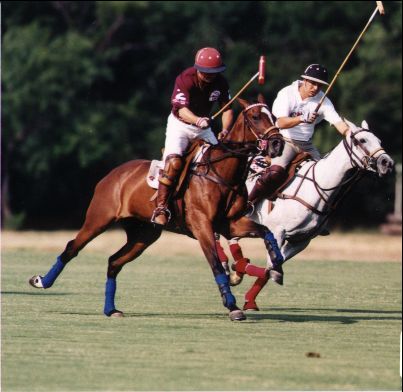|
Polo News
From Texas |

|
Las Colinas
Polo Club |
|
Polo News
From Texas |

|
Las Colinas
Polo Club |
Chukker #2 
|
|
A polo match begins when each team has lined up on their side of the field, facing the opposing players. The umpire "bowls in" the polo ball down the alley created between each team's mounts. From there, the action is fast. The team players are numbered 1 through 4, with player 1 the lead offensive player, and 4 the final defensive player. Compared to soccer or other field games, these positions seem more fluid. Given the relatively small size of the ball, and the high speed at which the player has to hit the ball, not to mention the many bounces the ball makes off any uneven playing surface, it is necessary for the other team members to back up the player in possession of the ball in case it is missed. Play is constant, except for time-outs and fouls. There are always two mounted umpires, and a "third man" on the sidelines. The third man's opinion is called for if the two mounted umpires cannot agree on a call. The players change directions after every goal scored. Each goal counts as one point. Fouls are called when a player compromises the safety of others on the field. Most fouls seem to be infringements on the right-of-way of the ball. Every time the ball is hit, there is an imaginary line of travel created. For safety reasons, no player can cross in front of that imaginary line created by the moving ball; to do so imposes a penalty. Penalties imposed, from most severe to least severe are Penalty 1: automatic goal, Penalty 2: 30 yard shot to an undefended goal, Penalty 3: 40 yards to an undefended goal, Penalty 4: 60 yards to an undefended goal, and Penalty 5: 150 yards (midfield). Bumping is allowed, and "riding off" another player from the ball is fine, as long as the player approaches the other at no more than a 45 degree angle. Players are also allowed to hook an opponent's mallet. Players have a variety of techniques to make a shot. The same shots can be made from the near side of the horse (the horse's left side), or the off side (the horse's right side). Fore shots are the most basic, hit from the side of the horse forward. Back shots are also hit from the side of the horse, but are hit to go backwards. Neck shots are those hit under the horse's neck, while tail shots are hit behind the horse's tail. The shots are described by the side, then the technique, so it is an "offside fore", or a "nearside back". For right-handed riders, the offside shots are the first mastered, with the nearside shots being more difficult to master. Now, armed with a better understanding of what goes on at a polo match, it's time for you to head to the polo fields to begin enjoying the sport! |